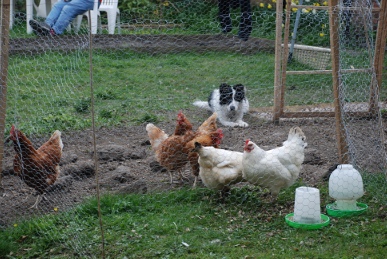
Wednesday 1st April – Home – Over to Newland Grange, just north of Malvern, to collect a pair of Light Sussex Cross hens. The owner’s young son deals with us as his mother has popped out. He asks us which hens we want, but we are not fussed and take the first two he catches. Into a box, much to the interest of Maddy and then back home. I have made a small side pen to the run with a bit of fencing and let them out in there. Immediately, Ginger starts up a row and is quickly joined by Freckles. Spotty goes over to look at them but they are more interested in the grass and water. Ginger stomps up and down clucking loudly. By now Kay has  named them – Jaq and Jill (Light Sussex – Jack and Jill the Sussex windmills – well, yes....) Eventually there is a face off between Ginger and Jaq who rears up and puffs her neck feathers out. This results in Ginger retreating noisily and pecking Spotty and Freckles in turn to ensure she is still boss in this part of the run. Later, Spotty and Jaq have a stand-off – hackles raised and some kick-boxing at the fence between them. It looks like it will be interesting when they are put together! I plan to introduce them into the coop after dark and they can come out together tomorrow. A Blackcap has been singing in the mistletoe covered apple tree. Another is singing towards the end of the garden. Robins and Dunnocks are also in song, although it is not easy sorting them out over the racket Ginger is still making. Various trees are coming into leaf and we can see that some of the very old trees against the walls are pears. There are probably four of them, but they are in poor condition and the parts coming into leaf may well be suckers off the rooting stock, but time will tell. Daffodils are at their best now and tulips are just opening. The greenhouse is full of pots and trays of seedlings.
named them – Jaq and Jill (Light Sussex – Jack and Jill the Sussex windmills – well, yes....) Eventually there is a face off between Ginger and Jaq who rears up and puffs her neck feathers out. This results in Ginger retreating noisily and pecking Spotty and Freckles in turn to ensure she is still boss in this part of the run. Later, Spotty and Jaq have a stand-off – hackles raised and some kick-boxing at the fence between them. It looks like it will be interesting when they are put together! I plan to introduce them into the coop after dark and they can come out together tomorrow. A Blackcap has been singing in the mistletoe covered apple tree. Another is singing towards the end of the garden. Robins and Dunnocks are also in song, although it is not easy sorting them out over the racket Ginger is still making. Various trees are coming into leaf and we can see that some of the very old trees against the walls are pears. There are probably four of them, but they are in poor condition and the parts coming into leaf may well be suckers off the rooting stock, but time will tell. Daffodils are at their best now and tulips are just opening. The greenhouse is full of pots and trays of seedlings.
Thursday 2nd April – Home – Plans seldom go smoothly. We went out to the run last night to put the new girls into the hen house – and Jaq was missing. Not sure how she escaped because I had clipped her wings as soon as we got them home. We searched in the dark but she could not be found, however, I reckoned she would have roosted somewhere and would be around at daybreak. I put Jill in the hen house and went back to the football on television. This morning, as expected, Jaq was strutting around near the fruit cage. I scooped her up and put her in the run. Predictably, all hell broke loose with much bullying of the new girls. There is not much we can do but wait for them to all settle down.
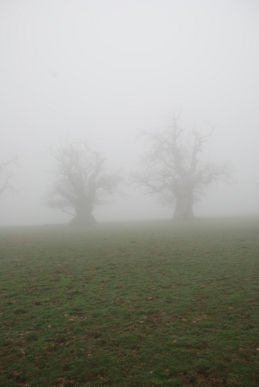
Friday 3rd April – Croft Castle – Primroses glow beneath the ancient oaks lining the avenue from the road to the Gothic arch entrance to Croft Castle. Off across the cow pasture where pregnant cattle bellow and low in the thick mist. A little calf staggers to his mother’s udders. Maddy is very uncertain about these huge creatures barely discernible in the greyness. Over the stile  and up the field of Spanish Chestnuts which stand like ghosts of Ents looming out of clouds. A Great Spotted Woodpecker is drumming in the woods. Tits squeak otherwise there is a close silence. Up by the gate to the Forestry Commission plantation a Chestnut has vivid emerald leaves just opening and tiny embryonic flower candles. A Nuthatch runs along the branches. White Anemones carpet the woods. A Chiffchaff calls some way off and a Great Tit squeals. Approaching Croft Ambrey it is noticeable how extensive are the defensive ramparts. A degraded bank runs along the edge of the path by the wood, a long way down the slope from the main ramparts. A long low ridge runs down from the main fort. It is a “Pillow Mound”. Sometime thought to be prehistoric because of associated finds and even earlier called “Giant’s Graves”, they are now known to be mediaeval “coney garths”, man-made rabbit warrens. The prehistoric finds are usually because they are often built close to older sites and rabbits are good excavators! Suddenly a large dog looms in the mist. Maddy seems unconcerned and not without reason, the “dog” is revealed as a tree stump with two “ears” of wood sticking up. It is interesting to note the size distortion in the mist – the stump is more than twenty times larger than the biggest dog! Violets peek out of the bank of the eastern gate. Down the slope the path joins the Mortimer Trail. Gnarled trees stand in ancient glory. The trail heads down the hillside through conifers. The sides of the path are covered with the wonderfully named Opposite-Leaved Golden Saxifrage (Chrysosplenium oppositifolium), a carpet of tiny yellow flowers in a nest of bright green leaves. The path is soon a
and up the field of Spanish Chestnuts which stand like ghosts of Ents looming out of clouds. A Great Spotted Woodpecker is drumming in the woods. Tits squeak otherwise there is a close silence. Up by the gate to the Forestry Commission plantation a Chestnut has vivid emerald leaves just opening and tiny embryonic flower candles. A Nuthatch runs along the branches. White Anemones carpet the woods. A Chiffchaff calls some way off and a Great Tit squeals. Approaching Croft Ambrey it is noticeable how extensive are the defensive ramparts. A degraded bank runs along the edge of the path by the wood, a long way down the slope from the main ramparts. A long low ridge runs down from the main fort. It is a “Pillow Mound”. Sometime thought to be prehistoric because of associated finds and even earlier called “Giant’s Graves”, they are now known to be mediaeval “coney garths”, man-made rabbit warrens. The prehistoric finds are usually because they are often built close to older sites and rabbits are good excavators! Suddenly a large dog looms in the mist. Maddy seems unconcerned and not without reason, the “dog” is revealed as a tree stump with two “ears” of wood sticking up. It is interesting to note the size distortion in the mist – the stump is more than twenty times larger than the biggest dog! Violets peek out of the bank of the eastern gate. Down the slope the path joins the Mortimer Trail. Gnarled trees stand in ancient glory. The trail heads down the hillside through conifers. The sides of the path are covered with the wonderfully named Opposite-Leaved Golden Saxifrage (Chrysosplenium oppositifolium), a carpet of tiny yellow flowers in a nest of bright green leaves. The path is soon a 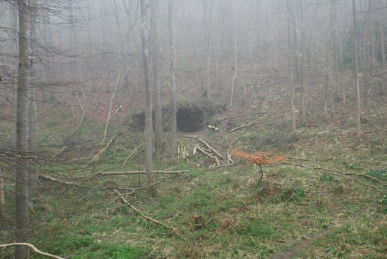 track that has been roughly cobbled with limestone. Dog Mercury and Ramsons take over the ground coverage. A stream appears in a deep cutting. Opposite there are drifts of daffodils in the woods. Up the hill there is a
track that has been roughly cobbled with limestone. Dog Mercury and Ramsons take over the ground coverage. A stream appears in a deep cutting. Opposite there are drifts of daffodils in the woods. Up the hill there is a 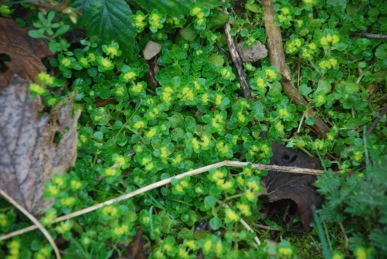 drystone built grotto from the 1790s. A grove of Douglas Firs from the mid 19th century stand tall. A lime-kiln, also 19th century sits beside a small quarry where the limestone was dug out and turned into quicklime in the wood-fired kiln. A row of fishing ponds wends their way down the valley. A “Gothick” pumphouse stands between two ponds. It used to pump water up to the castle. A drake Mallard is quietly quacking on one of the ponds, he appears to be alone, plaintively calling for a mate. A path leads up out of the valley back to the Oak avenue.
drystone built grotto from the 1790s. A grove of Douglas Firs from the mid 19th century stand tall. A lime-kiln, also 19th century sits beside a small quarry where the limestone was dug out and turned into quicklime in the wood-fired kiln. A row of fishing ponds wends their way down the valley. A “Gothick” pumphouse stands between two ponds. It used to pump water up to the castle. A drake Mallard is quietly quacking on one of the ponds, he appears to be alone, plaintively calling for a mate. A path leads up out of the valley back to the Oak avenue.
Sunday 5th April – Leominster – The temperature fell considerably overnight in the clear skies leading to a frost. The sun is bright over Eaton Hill. A raptor flies overhead at some height – probably a Peregrine Falcon but possibly a returning summer visitor, the Hobby. The Great Spotted Woodpecker in the churchyard is still drumming for all he is worth. Blackbirds are loud in song. Yesterday, a pair were mating by the Minster and, for some reason, being hassled by House Sparrows throughout their brief trysts. Nearly all the trees now are either in leaf or at least fat buds have appeared ready to burst. Many Cherry trees have already flowered; the flowers on one in the garden have already fallen. There is still much squabbling between the two sets of hens. The Warrens are real bullies, and it is interesting to note that Spotty, who was at the bottom of the pecking order and frequently bullied by Ginger, is probably the worse. Friday night saw some rain, the first for weeks. It had a magical effect on the garden with stuff shooting forward. I had abandoned hope of a row of carrots I had sown but now there is a thick line of tiny seedlings. A Mistle Thrush sings his gorgeous song from the top of one of the ivy-covered apple trees at the end of the garden.

Monday 6th April – Home – A cold and mainly grey day, but the forecast rain has not arrived by early evening. The first row of peas, grown in the greenhouse in a length of guttering, has been transplanted into one of the vegetable beds. A row of Spring Onions, White Lisbon is sown. The pots and pots of tomato seedlings seem to be progressing steadily as do the chili peppers. Only four eggs were laid yesterday, but five today. It is likely that Jaq did not lay yesterday as she has produced an enormous one today! They seem to be settling down now, far less squabbles. A cronk comes from overhead as a raven passes. The rain now arrives.
Wednesday 8th April – Home – More welcome rain last night, but it appears the weeds have benefited most. Clouds pass over darkening the garden for a few moments before it is bathed in sunlight again. Along the side walls of the garden are some very old Pear trees. Their bark is a crumbling lacework of brown rectangles. Some are entirely dead but most have a few branches which are now bejewelled with white blossom. Jackdaws are taking sticks into a space in the top of a chimney stack next door. This may be a risky place for a nest as Grey Squirrels have been seen in and out of this hole in the winter. It remains to be seen if it will be a Jackdaw nursery or a squirrel larder. Progress in the greenhouse is generally slow. The nights are still cool and this is holding back most plants. The chili pepper plants in the bathroom are three times the size of those in the greenhouse. The girls laid five eggs today. I boiled one of Jaq’s giant efforts for breakfast today but there was something very wrong with it. Inside it was watery and smelled off. Hopefully her more recent efforts will be normal, at least their size is now. Only a few broad bean plants survived the winter, but two that did are now flowering. The spring sown ones are catching them up fast.
Tuesday 14th April – Leominster – The Easter weekend was warm, so much sitting in the summerhouse doing not a lot. Having said that, I did rebuild one of my computers with a new motherboard and CPU and had the very unusual experience of it all working first time! There has been a shower overnight but no substantive rain, which the garden could do with. The dawn chorus is loud around the Minster as the sun peeks through a narrow gap in the curtains of cloud. Chiffchaffs and Blackcaps have joined the thrushes and finches in song. A Common Buzzard glides down the valley and a Grey Heron heads upstream with steady, purposeful wing beats. The Daffodils are almost finished. Primroses and Cowslips a dotted like islands in the sea of grass beyond the churchyard. Marsh Marigolds shine out of the still dull brown reeds by the pond.
Sunday 19th April – Brighton – We had driven through rain and mist on Friday down to Brighton for the weekend. Yesterday started dull, misty and quite chilly with a northerly wind. This morning is brighter. Up on Hollingbury Camp the views are magnificent. The South Downs, rolling hills of chalk, stretch away to the north, east and west. To the south lies the city (I find this a difficult concept, my home town is still a town to me!) Beyond is the English Channel. Blackbirds, Song and Mistle Thrush and a Whitethroat are all in song. A Swallow swoops low over the closely cropped golf course fairways. Spotted Orchids stand tall and richly purple in the camp. The gorse bushes shine yellow. Mount Caburn, some twelve miles away, is gloomy and dark, its Iron Age fort ringing a noble forehead of chalk under a sky split by a shaft of sunshine.
Leominster – We have a very pleasant drive home across a green England. Beyond the Downs we pass the wood-edged fields and brick farms of Sussex and Hampshire. Rivers all head south towards the Channel. The road then crosses the wide open spaces of the Salisbury Plain in Wiltshire. Through the historic town of Marlborough and then on past the great and now silent Honda factory of Swindon – having lost its great industry, railway engine building, one hopes it will not lose its replacement. Then on into the Cotswolds and down to Gloucester. Past the Malverns and then home. In the evening we go to a concert by the Birmingham Philharmonic Orchestra in the Minster. They play some 20th century pieces – a particularly good “The Lark Ascending” by Vaughan Williams. The second half with “Land of Hope and Glory” is a bit too “pop” for me, but it is an excellent evening.
Tuesday 21st April – Marlborough – I had rather stupidly left my bag containing my camera and other valuables in Brighton. So Chris and Penny kindly suggested we meet halfway to return it. Halfway is the pleasant town of Marlborough. The high street is a delightful mixture of buildings from the 17th century to modern. The car parks are hidden down beside the River Kennet, where fat Brown Trout lay in the current, their tails flicking lazily. The name Marlborough is supposed to come from Merlin’s Barrow, reference to a mound near the town which may be older than Silbury Hill. The town motto is “Ubi nunc sapientis ossa Merlini - Where now are the bones of wise Merlin”. However, the name most probably means “Marl Berg” a chalk hillock and a reference to the practice of digging chalk subsoil called “marl”. A wooden castle was built on the mound in the late 11th century. At the end of the high street is the Church of St Peter and St Paul. Now disused, it contains a craft gallery and café but still retains the essence of an ecclesiastical building. There was a church here by 1100, but the present building was started in 1460. In 1498, Thomas Wolsey, later Cardinal, Archbishop of York and Chancellor of the Kingdom, was ordained a priest. The church fell into disrepair in the mid 19th century but restored from 1862. In the 1870s the chancel walls were plastered and painted with stencil designs. There is some pleasant Victorian glass. Small alleyways lead off the high street to pretty cottages. One yard was used by “The Lord Chamberlain’s Men”, the touring company of William Shakespeare for an play in 1597.
Thursday 23rd April – Weobley – Another visit to this pretty village, this time following a talk at the local Civic Society on the history of the castle I have a new perspective. Down by the car park is Bell Square, formerly the centre of the village. Round a corner is Broad Street, now the main shopping street. It divides into two with a pleasant long triangular green in the middle. However, until November 1943 there was a triangle of timber-framed buildings from the 15th - 17th centuries, but in that month they were destroyed by fire. 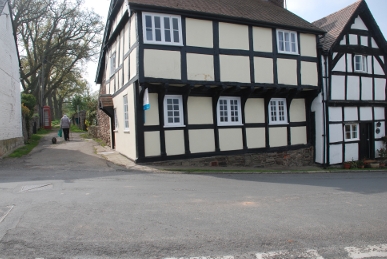 During the late mediaeval, Tudor and Stuart times, Weobley was a wealthy town, sending two members to Parliament. Its wealth was based mainly on sheep and as agricultural practices changed so the fortunes of the town declined. At the top of Broad Street, on High Street are two timber-framed houses either side of the path that leads to the castle remains. They stand on old stone footings, which are the remains of the castle gatehouses. Up the path and round the castle mound beside a “leet”, a stream dug to feed water to the village. On a kink in the leet stood a mill, long gone. The field beyond the castle site has sheep grazing so I do not enter with Maddy. Exploratory archaeology was undertaken a few years back in the area where aerial photographs have show ditches and banks consistent with Iron Age settlement but nothing conclusive was found. Back on the castle site, two mediaeval houses stood in front of the main castle keep, their floors were found during the investigations. US Army huts stood on the site during the war. Beyond the area of the castle stand a number of cottages which investigations have shown are built of stone scavenged from the castle after it fell into ruin. On the way out of the village, Swallows are perching on wires.
During the late mediaeval, Tudor and Stuart times, Weobley was a wealthy town, sending two members to Parliament. Its wealth was based mainly on sheep and as agricultural practices changed so the fortunes of the town declined. At the top of Broad Street, on High Street are two timber-framed houses either side of the path that leads to the castle remains. They stand on old stone footings, which are the remains of the castle gatehouses. Up the path and round the castle mound beside a “leet”, a stream dug to feed water to the village. On a kink in the leet stood a mill, long gone. The field beyond the castle site has sheep grazing so I do not enter with Maddy. Exploratory archaeology was undertaken a few years back in the area where aerial photographs have show ditches and banks consistent with Iron Age settlement but nothing conclusive was found. Back on the castle site, two mediaeval houses stood in front of the main castle keep, their floors were found during the investigations. US Army huts stood on the site during the war. Beyond the area of the castle stand a number of cottages which investigations have shown are built of stone scavenged from the castle after it fell into ruin. On the way out of the village, Swallows are perching on wires.
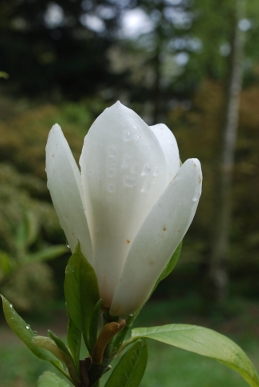
Tuesday 28th April – Queenswood Country Park – It is dull but the rain keeps away so we head up Dinmore Hill to the Country Park. Almost as soon as we start walking Maddy disgraces herself by running up to a pair of black Labradors and barking at them. I apologise to their owner and Maddy and I have sharp words! Primroses and Anemones are still in flower but coming to the end of their season. Bluebells are emerging in the woods. Some Magnolias have huge white or pink flowers, splashed with rain drops. Chiffchaffs 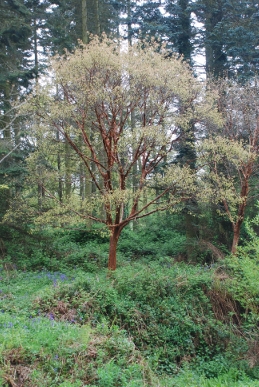 are calling in all directions. A Chaffinch at the top of a tree is emitting a call I have never heard before. We continue on to the look-out point. All around leaves are pristine and various shades of bright green. The clouds hang over the landscape to the south, the hills are dark and gloomy. Large white areas of poly-tunnels are now scattered across the view. Back down the path where a Treecreeper scurries up a trunk. Near to the road there are vast drifts of Bluebells in the trees. Near the pond a tree has bark the colour that children use for trees when using wax crayons, much too much red in the brown. A flowering Cherry with white blossom is like a lace umbrella.
are calling in all directions. A Chaffinch at the top of a tree is emitting a call I have never heard before. We continue on to the look-out point. All around leaves are pristine and various shades of bright green. The clouds hang over the landscape to the south, the hills are dark and gloomy. Large white areas of poly-tunnels are now scattered across the view. Back down the path where a Treecreeper scurries up a trunk. Near to the road there are vast drifts of Bluebells in the trees. Near the pond a tree has bark the colour that children use for trees when using wax crayons, much too much red in the brown. A flowering Cherry with white blossom is like a lace umbrella.

 named them – Jaq and Jill (Light Sussex – Jack and Jill the Sussex windmills – well, yes....) Eventually there is a face off between Ginger and Jaq who rears up and puffs her neck feathers out. This results in Ginger retreating noisily and pecking Spotty and Freckles in turn to ensure she is still boss in this part of the run. Later, Spotty and Jaq have a stand-off – hackles raised and some kick-boxing at the fence between them. It looks like it will be interesting when they are put together! I plan to introduce them into the coop after dark and they can come out together tomorrow. A Blackcap has been singing in the mistletoe covered apple tree. Another is singing towards the end of the garden. Robins and Dunnocks are also in song, although it is not easy sorting them out over the racket Ginger is still making. Various trees are coming into leaf and we can see that some of the very old trees against the walls are pears. There are probably four of them, but they are in poor condition and the parts coming into leaf may well be suckers off the rooting stock, but time will tell. Daffodils are at their best now and tulips are just opening. The greenhouse is full of pots and trays of seedlings.
named them – Jaq and Jill (Light Sussex – Jack and Jill the Sussex windmills – well, yes....) Eventually there is a face off between Ginger and Jaq who rears up and puffs her neck feathers out. This results in Ginger retreating noisily and pecking Spotty and Freckles in turn to ensure she is still boss in this part of the run. Later, Spotty and Jaq have a stand-off – hackles raised and some kick-boxing at the fence between them. It looks like it will be interesting when they are put together! I plan to introduce them into the coop after dark and they can come out together tomorrow. A Blackcap has been singing in the mistletoe covered apple tree. Another is singing towards the end of the garden. Robins and Dunnocks are also in song, although it is not easy sorting them out over the racket Ginger is still making. Various trees are coming into leaf and we can see that some of the very old trees against the walls are pears. There are probably four of them, but they are in poor condition and the parts coming into leaf may well be suckers off the rooting stock, but time will tell. Daffodils are at their best now and tulips are just opening. The greenhouse is full of pots and trays of seedlings.
 and up the field of Spanish Chestnuts which stand like ghosts of Ents looming out of clouds. A Great Spotted Woodpecker is drumming in the woods. Tits squeak otherwise there is a close silence. Up by the gate to the Forestry Commission plantation a Chestnut has vivid emerald leaves just opening and tiny embryonic flower candles. A Nuthatch runs along the branches. White Anemones carpet the woods. A Chiffchaff calls some way off and a Great Tit squeals. Approaching Croft Ambrey it is noticeable how extensive are the defensive ramparts. A degraded bank runs along the edge of the path by the wood, a long way down the slope from the main ramparts. A long low ridge runs down from the main fort. It is a “Pillow Mound”. Sometime thought to be prehistoric because of associated finds and even earlier called “Giant’s Graves”, they are now known to be mediaeval “coney garths”, man-made rabbit warrens. The prehistoric finds are usually because they are often built close to older sites and rabbits are good excavators! Suddenly a large dog looms in the mist. Maddy seems unconcerned and not without reason, the “dog” is revealed as a tree stump with two “ears” of wood sticking up. It is interesting to note the size distortion in the mist – the stump is more than twenty times larger than the biggest dog! Violets peek out of the bank of the eastern gate. Down the slope the path joins the Mortimer Trail. Gnarled trees stand in ancient glory. The trail heads down the hillside through conifers. The sides of the path are covered with the wonderfully named Opposite-Leaved Golden Saxifrage (Chrysosplenium oppositifolium), a carpet of tiny yellow flowers in a nest of bright green leaves. The path is soon a
and up the field of Spanish Chestnuts which stand like ghosts of Ents looming out of clouds. A Great Spotted Woodpecker is drumming in the woods. Tits squeak otherwise there is a close silence. Up by the gate to the Forestry Commission plantation a Chestnut has vivid emerald leaves just opening and tiny embryonic flower candles. A Nuthatch runs along the branches. White Anemones carpet the woods. A Chiffchaff calls some way off and a Great Tit squeals. Approaching Croft Ambrey it is noticeable how extensive are the defensive ramparts. A degraded bank runs along the edge of the path by the wood, a long way down the slope from the main ramparts. A long low ridge runs down from the main fort. It is a “Pillow Mound”. Sometime thought to be prehistoric because of associated finds and even earlier called “Giant’s Graves”, they are now known to be mediaeval “coney garths”, man-made rabbit warrens. The prehistoric finds are usually because they are often built close to older sites and rabbits are good excavators! Suddenly a large dog looms in the mist. Maddy seems unconcerned and not without reason, the “dog” is revealed as a tree stump with two “ears” of wood sticking up. It is interesting to note the size distortion in the mist – the stump is more than twenty times larger than the biggest dog! Violets peek out of the bank of the eastern gate. Down the slope the path joins the Mortimer Trail. Gnarled trees stand in ancient glory. The trail heads down the hillside through conifers. The sides of the path are covered with the wonderfully named Opposite-Leaved Golden Saxifrage (Chrysosplenium oppositifolium), a carpet of tiny yellow flowers in a nest of bright green leaves. The path is soon a  track that has been roughly cobbled with limestone. Dog Mercury and Ramsons take over the ground coverage. A stream appears in a deep cutting. Opposite there are drifts of daffodils in the woods. Up the hill there is a
track that has been roughly cobbled with limestone. Dog Mercury and Ramsons take over the ground coverage. A stream appears in a deep cutting. Opposite there are drifts of daffodils in the woods. Up the hill there is a  drystone built grotto from the 1790s. A grove of Douglas Firs from the mid 19th century stand tall. A lime-kiln, also 19th century sits beside a small quarry where the limestone was dug out and turned into quicklime in the wood-fired kiln. A row of fishing ponds wends their way down the valley. A “Gothick” pumphouse stands between two ponds. It used to pump water up to the castle. A drake Mallard is quietly quacking on one of the ponds, he appears to be alone, plaintively calling for a mate. A path leads up out of the valley back to the Oak avenue.
drystone built grotto from the 1790s. A grove of Douglas Firs from the mid 19th century stand tall. A lime-kiln, also 19th century sits beside a small quarry where the limestone was dug out and turned into quicklime in the wood-fired kiln. A row of fishing ponds wends their way down the valley. A “Gothick” pumphouse stands between two ponds. It used to pump water up to the castle. A drake Mallard is quietly quacking on one of the ponds, he appears to be alone, plaintively calling for a mate. A path leads up out of the valley back to the Oak avenue.
 During the late mediaeval, Tudor and Stuart times, Weobley was a wealthy town, sending two members to Parliament. Its wealth was based mainly on sheep and as agricultural practices changed so the fortunes of the town declined. At the top of Broad Street, on High Street are two timber-framed houses either side of the path that leads to the castle remains. They stand on old stone footings, which are the remains of the castle gatehouses. Up the path and round the castle mound beside a “leet”, a stream dug to feed water to the village. On a kink in the leet stood a mill, long gone. The field beyond the castle site has sheep grazing so I do not enter with Maddy. Exploratory archaeology was undertaken a few years back in the area where aerial photographs have show ditches and banks consistent with Iron Age settlement but nothing conclusive was found. Back on the castle site, two mediaeval houses stood in front of the main castle keep, their floors were found during the investigations. US Army huts stood on the site during the war. Beyond the area of the castle stand a number of cottages which investigations have shown are built of stone scavenged from the castle after it fell into ruin. On the way out of the village, Swallows are perching on wires.
During the late mediaeval, Tudor and Stuart times, Weobley was a wealthy town, sending two members to Parliament. Its wealth was based mainly on sheep and as agricultural practices changed so the fortunes of the town declined. At the top of Broad Street, on High Street are two timber-framed houses either side of the path that leads to the castle remains. They stand on old stone footings, which are the remains of the castle gatehouses. Up the path and round the castle mound beside a “leet”, a stream dug to feed water to the village. On a kink in the leet stood a mill, long gone. The field beyond the castle site has sheep grazing so I do not enter with Maddy. Exploratory archaeology was undertaken a few years back in the area where aerial photographs have show ditches and banks consistent with Iron Age settlement but nothing conclusive was found. Back on the castle site, two mediaeval houses stood in front of the main castle keep, their floors were found during the investigations. US Army huts stood on the site during the war. Beyond the area of the castle stand a number of cottages which investigations have shown are built of stone scavenged from the castle after it fell into ruin. On the way out of the village, Swallows are perching on wires.
 are calling in all directions. A Chaffinch at the top of a tree is emitting a call I have never heard before. We continue on to the look-out point. All around leaves are pristine and various shades of bright green. The clouds hang over the landscape to the south, the hills are dark and gloomy. Large white areas of poly-tunnels are now scattered across the view. Back down the path where a Treecreeper scurries up a trunk. Near to the road there are vast drifts of Bluebells in the trees. Near the pond a tree has bark the colour that children use for trees when using wax crayons, much too much red in the brown. A flowering Cherry with white blossom is like a lace umbrella.
are calling in all directions. A Chaffinch at the top of a tree is emitting a call I have never heard before. We continue on to the look-out point. All around leaves are pristine and various shades of bright green. The clouds hang over the landscape to the south, the hills are dark and gloomy. Large white areas of poly-tunnels are now scattered across the view. Back down the path where a Treecreeper scurries up a trunk. Near to the road there are vast drifts of Bluebells in the trees. Near the pond a tree has bark the colour that children use for trees when using wax crayons, much too much red in the brown. A flowering Cherry with white blossom is like a lace umbrella.